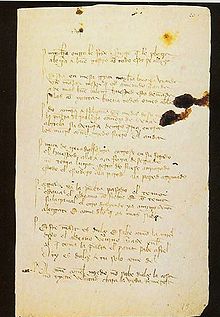The Book of Good Love
 |
|
| Author | Juan Ruiz Archpriest of Hita |
|---|---|
| Original title | El libro del buen amor |
| Country | Spain |
| Language | Spanish |
| Genre | mester de clerecía |
| Publisher | None |
|
Publication date
|
1330; expansion completed 1343 |
| Media type | Manuscript |
The Book of Good Love (El libro de buen amor), considered to be one of the masterpieces of Spanish poetry, is a semi-biographical account of romantic adventures by Juan Ruiz, the Archpriest of Hita, the earliest version of which dates from 1330; the author completed it with revisions and expansions in 1343.
The work is considered as the best piece in the medieval genre known as mester de clerecía.
The Book begins with prayers and a guide as to how to read the work, followed by stories each containing a moral and often comical tale.
The Book of Good Love is a varied and extensive composition of 1728 stanzas, centering on the fictitious autobiography of Juan Ruiz, Archpriest of Hita. Today three manuscripts of the work survive: the Toledo (T) and Gayoso (G) manuscripts originating from the fourteenth century, and the Salamanca (S) manuscript copied at the start of the fifteenth century by Alonso de Paradinas. All three manuscripts have various pages missing, which prevents a complete reading of the book, and each manuscript varies extensively from each other due to the diversions of the authors. The work most commonly read today was suggested by Ramón Menéndez Pidal in 1898 based on sections from all three manuscripts.
The book is famous for its variety of:
The work is composed of the following:
The title The Book of Good Love is inferred from the text, and who or what Good Love may be is not revealed by the author.
The Book of Good Love explains how men must be careful about Love that can be Good (el buen amor) or Foolish (el loco amor). The Good Love is God's one and is preferred to the Foolish love which only gives men sins. Juan Ruiz gives the reader a lot of examples to explain his theory and avoid Foolish love in name of Good one.
...
Wikipedia
